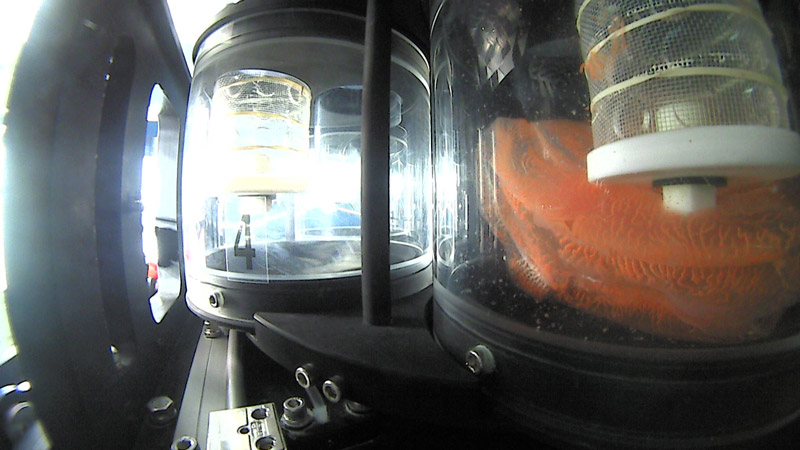Okeanos Explorer Sampling FAQs

Q: Why are there limits on the number and type of samples collected during expeditions on NOAA Ship Okeanos Explorer?
A: The philosophy that guides NOAA Ocean Exploration’s sampling during expeditions on Okeanos Explorer purposely differs from sampling on conventional research expeditions. The objective of exploration sampling during expeditions on Okeanos Explorer is to collect a limited number of biological and geological samples for the sole purpose of broadly characterizing a dive site/area of interest. This, combined with Okeanos Explorer’s limited onboard processing and storage capabilities, means that there are fewer samples collected during NOAA Ocean Exploration’s remotely operated vehicle (ROV) dive operations than those conducted during conventional research expeditions.
The type of samples collected are limited to those that can be safely and efficiently collected using the sampling tools on the ROV. The number of samples collected also varies depending on the expedition, onboard staffing, and space available on the ROV and ship. For each expedition, the science leads and the expedition coordinator determine the appropriate amount of dive time devoted to sampling versus other dive priorities, such as video collection and close-up imaging.
Q: What happens to the biological samples collected during expeditions on Okeanos Explorer? How are they processed and preserved on the ship?
A: Once a decision is made to collect a particular sample, the expedition’s science leads will ensure that it’s documented on video before it’s collected and that all relevant metadata (i.e., date, time, depth, latitude, longitude, temperature, dissolved oxygen, and salinity) are recorded at the time of collection.
Once a sample is brought aboard, it‘s inspected for associated organisms, photographed, labeled, and added to a database with all its relevant metadata. All associated organisms are separated from the primary samples and processed separately.
If biological samples are large enough to be subsampled, small tissue clippings (DNA samples) will be taken and preserved separately (in 95% ethanol) for DNA analyses and, in some cases, for histological examination (10% buffered formalin).
After biological samples are labeled and photographed, they are preserved in 95% ethanol, unless a formalin preservation (e.g., 10% buffered formalin) is preferred for a particular animal.
Q: How can I access biological samples collected during an expedition on Okeanos Explorer for my research?
A: Biological samples collected during expeditions on Okeanos Explorer expeditions are archived in the collections of the Smithsonian Institution’s National Museum of Natural History, which catalogs, curates, and makes them publicly available.
- Biological samples of invertebrate organisms are archived in the Invertebrate Zoology Collections . See their Collections Access web page for information on how to access invertebrate samples.
- Biological samples of fish are archived in the Division of Fishes of the Vertebrate Zoology Collections . See their Collections Access web page for information on how to access fish samples.
DNA samples are archived in the Biorepository at the National Museum of Natural History. These samples are linked to the catalog records in the Invertebrate Zoology or Division of Fishes of Vertebrate Zoology collections and can be accessed via their respective Collections Access web pages (see above). DNA samples collected between 2015 and 2018 are also archived at the Ocean Genome Legacy Center at Northeastern University. See their Request Samples web page for information on how to access DNA samples.
Q: How can I access geological samples collected during expeditions on Okeanos Explorer for my research?
A: NOAA partners with Oregon State University through its Cooperative Institute of Marine Resources Studies to archive geological samples. Geological samples collected during expeditions on Okeanos Explorer are archived through the Marine and Geology Repository at Oregon State University’s NOAA Collection (NOAA Rocks) . The repository provides online metadata about each geological sample. See their Request Samples web page for Information on how to access geological samples.
Q: How do I access digital data (e.g., images, metadata) associated with the samples collected during expeditions on Okeanos Explorer?
A: The Sampling Operations Database Application (SODA) is a Microsoft Access database used during expeditions on Okeanos Explorer to record the metadata of each sample collected during dive operations. After an expedition, the Science Team conducts quality control on the SODA entries, and then sample records are saved in a .csv file that is archived at NOAA’s National Centers for Environmental Information (NCEI) and available through the NOAA Ocean Exploration Data Atlas and the NOAA Ship Okeanos Explorer data landing pages. These tools also provide links to the sample repositories and show where samples were collected on an interactive map.
Q: Does active participation in expeditions on Okeanos Explorer provide privileged sample access?
A: Active participation in expeditions on Okeanos Explorer does not provide privileged access to collected samples. During expeditions on Okeanos Explorer, NOAA Ocean Exploration conducts systematic, telepresence-enabled exploration, which enables anyone to participate. In addition, consistent with the principles of open and equal data access, expedition results are freely available to anyone. Nevertheless, expedition participants are inevitably more familiar with expedition details, such as what samples are collected, so they do have an advantage. Specifically, they can make sample requests before some researchers even know they exist.